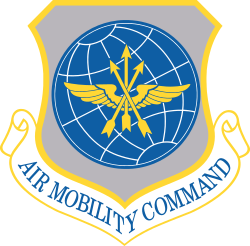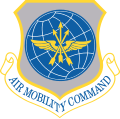Operations
The Special Air Mission originated with the World War II United States Army Air Forces' 10th Ferrying Squadron (AAFFC) in 1941. It was redesigned as the 21st Transport Transition Training Detachment of Air Transport Command (ATC) in 1942, and later redesignated as the 26th Transport Group. From September to December 1943, the 26th TG conducted the C-87 "Fireball" run, a weekly priority spare parts delivery flight between Fairfield, Ohio and Agra, India. It was lastly redesignated as the 503d Army Air Force Base Unit (AAFBU) in 1944. The last unit was part of the ATC North Atlantic Division. In 1946, it is known that the 503d AAFBU was involved in the transport of personnel to Bikini Atoll as part of the Atomic Bomb Testing mission.
When President Franklin D. Roosevelt flew to the Casablanca Conference in 1943 on board a commercial Boeing 314 Clipper Ship, he became the first U.S. president to fly while in office. Concerned about relying upon commercial airlines to transport the president, the USAAF leaders ordered the conversion of a military aircraft to accommodate the special needs of the Commander in Chief. In 1942, a modified B-24 Liberator (designated C-87A) was prepared for the use of President Roosevelt, however it was never used by him. The First Lady, Eleanor Roosevelt, however used the aircraft extensively in her travels around the United States and overseas to visit servicemen overseas.
After experiencing difficulties with the C-87, the USAAF arranged with Douglas Aircraft to construct a new transport aircraft specifically for presidential use. Nicknamed the "Sacred Cow", this modified C-54 Skymaster (VC-54C), which included a vertical lift in the lower fuselage for the President and his wheelchair, became the first military aircraft to transport a U.S. president when President Roosevelt took it to the Soviet Union for the Yalta Conference in February 1945. President Roosevelt used the Sacred Cow only once before his death in April 1945; however, the Sacred Cow remained in presidential service during the first 27 months of the Truman Administration. On 26 July 1947, President Truman signed the National Security Act of 1947 while on board the Sacred Cow. This act established the U.S. Air Force as an independent service, making the Sacred Cow the "birthplace" of the USAF.
Following the increased development of commercial air travel after World War II, Americans once again took to the air. Commercial airlines, made anemic under prohibitive wartime flying regulations and rationing of airplane fuel, were restored to vigor after the war with many World War II military aircraft being sold cheap to anyone with an idea to open an airway in the sky.
The result was too many civilian aircraft and not enough airfields to support them. This meant many government civilians couldn't get to where they needed to go on time. The Special Air Mission was created to ensure military airplanes were available to transport government employees between military bases. SAM Aircraft also had priority to land at civilian airfields, although this practice became less common as years went on.
The 503d Army Air Forces Base Unit was responsible for the operation of Presidential Aircraft until 27 September 1947 when the United States Air Force was created. At that time, the unit was redesignated as the 503d Air Force Base unit. The unit was nicknamed as the "Brass Hat Squadron". The 16th (later 1100th) Special Air Missions Group was created in 1948 and assigned to the newly created Military Air Transport Service. The mission of the group was to transport civilian government employees for Air Force and non-Air Force activities as directed by Air Force headquarters. The group consisted of eight squadrons, each strategically located adjacent to the headquarters of the agencies utilizing transportation furnished by the squadrons. This included the transportation of the president of the United States, the vice president, members of the cabinet, members of Congress, and other high-ranking American and foreign dignitaries.
In 1947, USAAF officials ordered the 29th production DC-6 to be modified as a replacement for the aging VC-54C Sacred Cow presidential aircraft. On 4 July 1947, a VC-118, a military version of the Douglas DC-6 commercial airliner, came into use. It differed from the standard DC-6 configuration in that the aft fuselage was converted into a stateroom; the main cabin seated 24 passengers or could be made up into 12 "sleeper" berths. The VC-118 was nicknamed "Independence" for the President Harry Truman's hometown in Missouri. In September 1947, this USAAF aircraft became a USAF aircraft with the establishment of the U.S. Air Force as an independent service. Probably the plane's most historic flight occurred when it carried President Truman to Wake Island in October 1950 to discuss the Korean situation with General of the Army Douglas MacArthur.
In May 1953, after nearly six years of White House service, the Independence was retired as a presidential aircraft and subsequently served several Air Force organizations as a VIP transport.
President Dwight D. Eisenhower traveled aboard the "Columbine II" and "Columbine III" from 1953 to 1961. This was a modified C-121 Constellation commercial transport, designated as a VC-121E, and was President Eisenhower's personal airplane between 1954 and 1961. Mrs. Eisenhower christened it Columbine III in honor of the official flower of Colorado, her adopted home state, in ceremonies on 24 November 1954. Columbine III served as the presidential aircraft until President Eisenhower left office in January 1961. It remained in service transporting government officials and visiting foreign dignitaries throughout the world until 1966.
A 1953 incident where Eisenhower's aircraft was "Air Force 8610" and an Eastern Airlines plane was "Eastern 8610" created the need to devise a unique call sign. The call sign "Air Force One" was classified during the 1950s to identify not only the president's plane, but when he was aboard. In September 1961, it became popularly known when it identified President John F. Kennedy flying aboard his C-118.
In 1961, the 1254th Air Transport Wing was moved from Washington National Airport to Andrews Air Force Base, Maryland, where it was later disestablished in January 1966. In its place, the 89th MAW Special Missions was activated and assigned to Andrews Air Force Base until the wing became a group on 30 September 1977.
In 1962, a VC-137C specifically purchased for use as Air Force One, entered into service with the tail number 26000. It is perhaps the most widely known and most historically significant presidential aircraft. SAM 26000 flew President John F. Kennedy to West Berlin in 1963, where he declared to West Berliners, "Ich bin ein Berliner," assuring them of continuing United States support in the face of Communist threats and the construction of the Berlin Wall. Kennedy also flew aboard SAM 26000 to Dallas, Texas, where he was assassinated on 22 November 1963—and it was on this airplane that vice president Lyndon B. Johnson was sworn in as the new president. SAM 26000 then carried John F. Kennedy's body and President Johnson back to Washington, D.C. Johnson also used 26000 to visit U.S. troops in Vietnam during the Vietnam War.
Beginning in 1970 Henry Kissinger used the aircraft for 13 trips to Paris, France, for secret meetings with the North Vietnamese. In February 1972 President Nixon flew aboard SAM 26000 on his historic "Journey for Peace" to the People's Republic of China (the first visit by an American president to China). In May 1972 SAM 26000 carried Nixon to the Soviet Union.
SAM 26000 was augmented in December 1972 by another VC-137, Special Air Mission 27000, with SAM 26000 retained as an alternate Air Force One aircraft until it was finally retired in 1998. Richard Nixon was the first president to use SAM 27000, and the newer VC-137 served every president until it was replaced by the two VC-25 aircraft (SAM 28000 and 29000) in 1990. However, SAM 27000 continued to remain in service as an Air Force Two and alternate Air Force One aircraft until retired in 2001.
In October 1981 the aircraft flew presidents Nixon, Ford and Carter, and former Secretary of State Kissinger to the funeral of the slain Egyptian President Anwar Sadat. In March 1983, Queen Elizabeth II of the United Kingdom flew on SAM 26000 during her trip to the United States when she visited the West Coast.
At a nationally televised event in May 1998, the USAF retired SAM 26000. This aircraft provided thirty-six years of service and accumulated more than 13,000 flying hours. SAM 27000 was similarly retired in August 2001.
The current Special Air Mission for presidential travel used a modified Boeing 747-200B (VC-25A). The two aircraft currently in U.S. service are highly modified, to include EMP hardening of all communications and avionics systems and an aerial refueling capability allowing the ability to refuel from USAF KC-135 Stratotanker, KC-10 Extender, and the beleaguered future KC-46 Pegasus aircraft. The VC-25s carry tail numbers 28000 and 29000. Although the Air Force One designation technically applies to the planes only while the President is aboard, the term is commonly applied to the VC-25s more generally. They often operate in conjunction with Marine One, a Marine Corps helicopter, typically a VH-3D Sea King, operated by Marine Helicopter Squadron ONE (HMX-1), which ferries the president to airports or other locations in circumstances where a vehicle motorcade would be inappropriate.
In the future, the VC-25A's will be replaced by the Boeing 747-8 derived VC-25B, and the VH-3D Sea King and VH-60N “White Hawk” helicopters will be replaced by a fleet of 23 Sikorsky S-92 based VH-92A helicopters.



